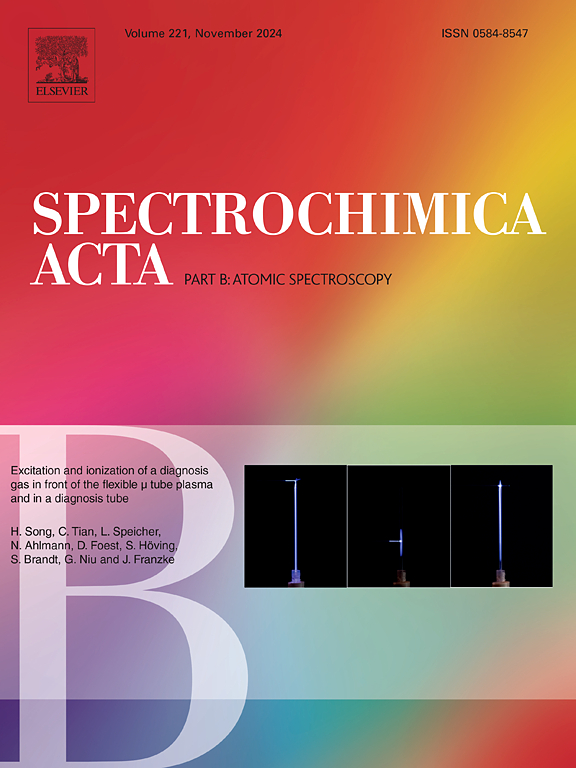Investigation of isotope shifts and Stark shifts in the strontium Rydberg state via 5s21S0→5s5p1P10→5p1/25p1/2→4d3/2nljn∗=39.4
IF 3.2
2区 化学
Q1 SPECTROSCOPY
引用次数: 0
Abstract
Resonance Ionization Spectrometry (RIS) is a highly sensitive analytical technique that utilizes differences in atomic structure between isotopes to achieve isotope selectivity. In recent years, multi-step resonance transitions have been developed to excite target isotopes from the ground state to high Rydberg states, simultaneously enhancing isotope selectivity and ionization efficiency, thereby improving the overall detection sensitivity of RIS. This study investigates a three-step RIS scheme ) for Sr isotope analysis, the isotope shifts of natural Sr isotopes were measured in the first and second transitions (), and the isotope shift for Sr-90 relative to Sr-88 was estimated. Additionally, Stark shifts of Sr-88 atoms in the Rydberg state under various external electric field conditions were precisely measured using a pulsed electric field. The results revealed that the external static electric fields caused energy level shifts for Sr-88 Rydberg atoms, with opposite directions. Furthermore, as the field strength increased, a transition from quadratic to linear Stark shifts was observed. These findings provide theoretical support for improving spectral resolution and transition selectivity in RIS methods involving Rydberg states. The detailed analysis of Rydberg state behavior under electric fields also offers valuable data for evaluating and compensating for field-induced perturbations in final energy level transitions, and serves as a reference for applying RIS to other elements or systems in similar Rydberg states for complex analyses.

求助全文
约1分钟内获得全文
求助全文
来源期刊
CiteScore
6.10
自引率
12.10%
发文量
173
审稿时长
81 days
期刊介绍:
Spectrochimica Acta Part B: Atomic Spectroscopy, is intended for the rapid publication of both original work and reviews in the following fields:
Atomic Emission (AES), Atomic Absorption (AAS) and Atomic Fluorescence (AFS) spectroscopy;
Mass Spectrometry (MS) for inorganic analysis covering Spark Source (SS-MS), Inductively Coupled Plasma (ICP-MS), Glow Discharge (GD-MS), and Secondary Ion Mass Spectrometry (SIMS).
Laser induced atomic spectroscopy for inorganic analysis, including non-linear optical laser spectroscopy, covering Laser Enhanced Ionization (LEI), Laser Induced Fluorescence (LIF), Resonance Ionization Spectroscopy (RIS) and Resonance Ionization Mass Spectrometry (RIMS); Laser Induced Breakdown Spectroscopy (LIBS); Cavity Ringdown Spectroscopy (CRDS), Laser Ablation Inductively Coupled Plasma Atomic Emission Spectroscopy (LA-ICP-AES) and Laser Ablation Inductively Coupled Plasma Mass Spectrometry (LA-ICP-MS).
X-ray spectrometry, X-ray Optics and Microanalysis, including X-ray fluorescence spectrometry (XRF) and related techniques, in particular Total-reflection X-ray Fluorescence Spectrometry (TXRF), and Synchrotron Radiation-excited Total reflection XRF (SR-TXRF).
Manuscripts dealing with (i) fundamentals, (ii) methodology development, (iii)instrumentation, and (iv) applications, can be submitted for publication.

 求助内容:
求助内容: 应助结果提醒方式:
应助结果提醒方式:


